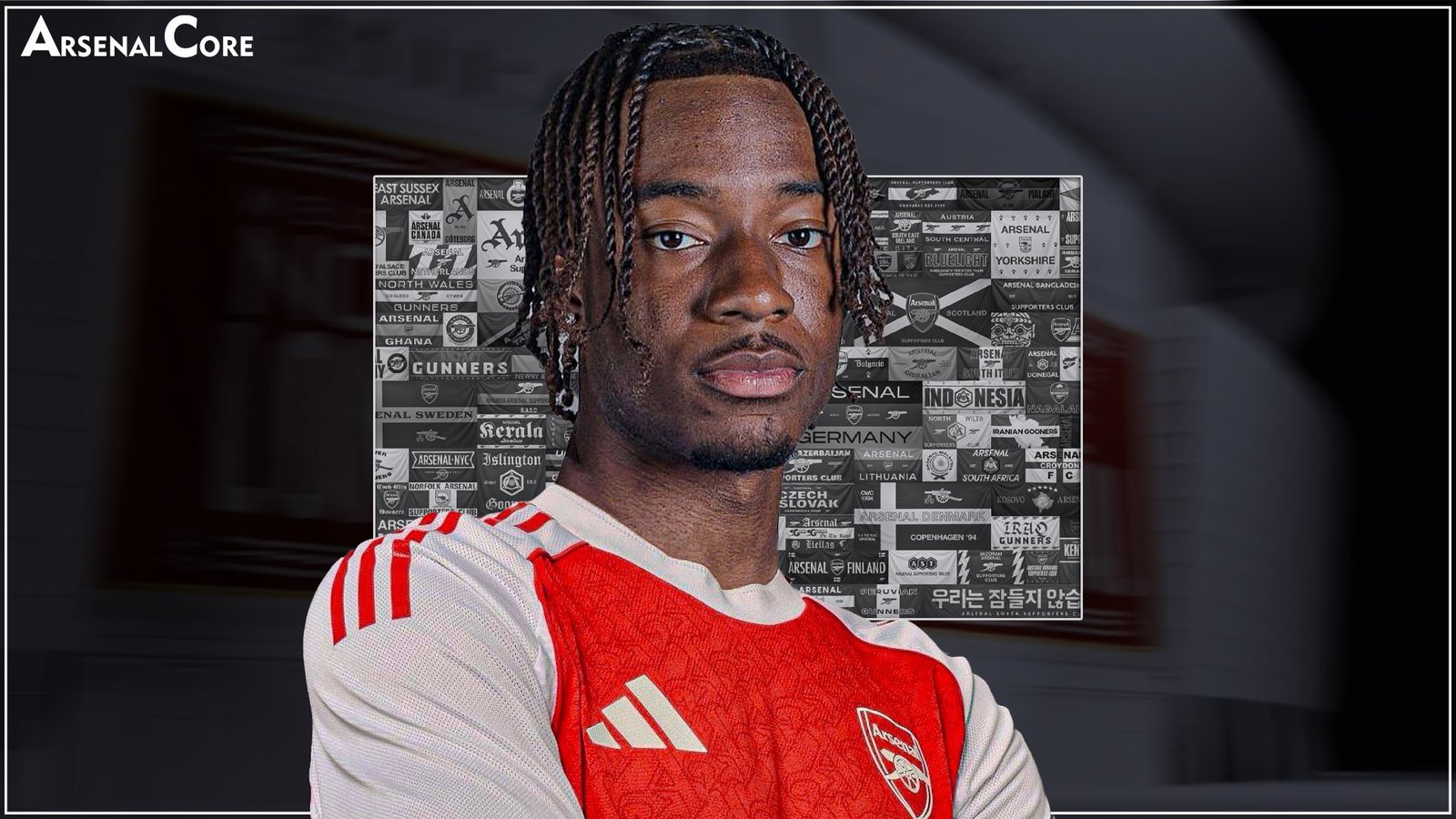Just a year ago, some Chelsea supporters boldly claimed Noni Madueke was “better than Bukayo Saka” after the winger scored a screamer for England’s U21s. Fast-forward to this summer, and the narrative has flipped. Many Arsenal fans are apprehensive about signing Madueke: #NoToMadueke even trended on Twitter amid reports the Gunners agreed personal terms with the 23-year-old. How did a player once touted as “Chelsea’s own Saka” become labeled “trash” by skeptics? More importantly, why should Arsenal ignore the noise and snap him up anyway?
Noni Madueke is a high potential signing…
At 23 years of age, Noni Madueke is an English winger brimming with talent and untapped potential. A left-footed right-sided attacker, he first made a name for himself at PSV Eindhoven with double-digit goal contributions in the Dutch league prompting Chelsea to sign him in January 2023. Standing about 1.82m tall, Madueke combines pace with power and loves to take defenders on. In his own words, “I like to get on the ball and be exciting… take players on, beat players when dribbling, be creative and score goals”. This fearless style made him a youth standout and earned him an England senior debut in 2023, where he fittingly replaced Bukayo Saka on the wing.
Crucially, Madueke is coming off a productive season for Chelsea. Despite the club’s struggles, he managed 7 goals and 3 assists in 32 Premier League appearances in 2024/25. That’s 10 goal contributions, a solid return for a youngster often used in rotation. Madueke even had a hat-trick in one game, showing his match-winning capability. His performances caught the eye of pundits who noted he was “key to when [Chelsea] were at their best” last season. It’s no surprise his market value hovers around £45-50 million in today’s inflated marke given how he is a rare blend of current production and sky-high ceiling, exactly the kind of player Arsenal’s project should target.
Analytically, Madueke’s profile is that of a high-impact, high-volume attacker. He shoots and dribbles at an elite rate, often leading his team in those categories. In fact, in the most recent Premier League season, he attempted more shots and dribbles per 90 minutes than Arsenal’s wingers like Gabriel Martinelli or Leandro Trossard. This aggressive output can make him a bit turnover-prone (high-risk moves sometimes fail), but it’s also the hallmark of a player who constantly tries to make things happen. As one analysis put it, “Madueke shoots a ton, he dribbles and carries a ton, and lots of Chelsea’s attacks flowed through him”. This all-action style drew comparisons to former Gunner Alexis Sánchez, a player who could frustrate with failed take-ons but also win games with moments of magic.
Perhaps the best indicator of Madueke’s potential is how he stacks up against his peers. When comparing wingers across Europe at a similar age, Madueke sits in a cohort of hot prospects with bright futures. Not everyone on that list hits their ceiling, but being in such company suggests Madueke has the tools to reach a very high level. In fact, when measured against some of Arsenal fans’ dream targets this summer: Eberechi Eze, Mohammed Kudus, Bryan Mbeumo, Madueke’s advanced stats are as good as or better than those players, despite being younger. This indicates that the raw numbers back up his talent. As analytics writer Scott Willis concluded, “he really fills out the stats… a supremely talented [player] with all of the tools to reach the highest level”. Such praise from data experts should assure fans that Madueke is far from “average,” he’s an exciting talent on an upward trajectory.
How can Noni Madueke fit at Arsenal under Mikel Arteta?
One big question is: Where would Madueke play at Arsenal? Pundit Micah Richards voiced what many are thinking, Madueke’s best position is right wing, “but he’s not going to play ahead of Bukayo Saka, is he?”. Indeed, Saka has the right-wing starting spot locked down as one of Arsenal’s star men. However, modern elite teams need depth and flexibility, and this is where Mikel Arteta can make use of Madueke’s versatility.
Firstly, Madueke would be an ideal rotation and backup option for Saka on the right flank. Arsenal struggled whenever Saka was sidelined or fatigued, in fact, Saka suffered a hamstring injury last season that kept him out for over three months, and the team lacked a like-for-like replacement. Currently, the depth chart at right wing is thin. Players like Reiss Nelson or Fabio Vieira can fill in occasionally, and Gabriel Jesus or Leandro Trossard have played there in a pinch, but none provide Saka’s unique blend of direct wing play. Madueke, however, is a left-footed right winger just like Saka, capable of hugging the touchline or cutting inside to shoot. By adding Madueke, Arteta can avoid over-reliance on Saka and keep the team’s attacking threat high even when Saka rests or misses a game.
Importantly, Madueke offers tactical qualities Arteta values. Arsenal’s system relies on wingers who can beat their man, create overloads, and threaten in 1v1 situations. Saka and Martinelli provided that last season; Madueke can do the same. His excellent dribbling ability and willingness to run at defenders could help Arsenal unlock stubborn defenses, especially late in games when introducing a fresh winger against tired full-backs. We saw glimpses of this at Chelsea, Madueke often came on and immediately injected directness into their attack. He’s also shown he can combine with overlapping fullbacks and play quick one-twos in tight spaces, something Arteta’s wide players are asked to do. Defensively, while he may need coaching to match Saka’s work rate, Madueke has the pace to track back and the physique to hold his own, so Arteta can mold his off-ball discipline.
There’s also the option that Madueke could feature on the left wing at times. At Chelsea, he was occasionally deployed on the left under different managers. While the left is not his natural flank, he handled it reasonably, cutting inside onto his stronger left foot isn’t an option there, but he can drive to the byline or link up with midfielders. If Arsenal needed to rest Martinelli or use Martinelli more centrally, Madueke on the left is a viable plan. This flexibility to play either wing is a bonus and increases his usefulness to the squad. Essentially, Arteta would have a multi-position attacking weapon predominantly a right winger, but not limited to one role.
Tactically, imagine scenarios with both Saka and Madueke on the field. If chasing a game, Arteta could field Saka on one wing and Madueke on the other to maximize 1v1 threat on both flanks (similar to how City sometimes played two natural wingers to pin back defenses). Madueke’s style actually complements Saka’s: while Saka is a more polished playmaker and crosser, Madueke is a relentless dribbler and shooter. Defenses that learn to contain Saka’s cutting inside might then struggle with Madueke’s unpredictability on the opposite side. Arteta could even experiment with Madueke as an attacking midfielder or second striker in certain formations given how his Transfermarkt profile notes he has occasionally played as a supporting striker or central attacking mid in youth games. In short, Arteta would gain a versatile, dynamic attacker who opens up new tactical possibilities and provides depth across the frontline.
Giving Bukayo Saka a breather
Perhaps the most compelling reason to sign Madueke is to protect and support Bukayo Saka, who has been Arsenal’s ironman. At just 23, Saka has carried a heavy load for two seasons, rarely ever getting a game off. In the 2022/23 campaign he played every Premier League match, and in 2023/24 he was again near the top of minutes played until injury struck in 2024/25. Arsenal’s title challenge faltered late in, in part because Saka finally hit a physical wall. Arteta cannot afford to run his star into the ground again, especially with Champions League football adding more fixtures.
Madueke’s arrival would directly address this issue. With a quality second option at right wing, Arteta can rotate Saka out more often without a huge drop in quality. For example, in early-round cup matches or against lower-table opposition at home, Madueke could start while Saka rests completely or comes on only if needed. This keeps Saka fresh for the crunch games. Even within games, having Madueke on the bench means Arteta can substitute Saka earlier when Arsenal have a lead, rather than leaving Saka on for 90 minutes out of necessity. Over a long season, those extra breathers add up and reduce injury risk.
Depth on the wings also helps Arsenal compete on multiple fronts. Last season, the Gunners lacked an adequate backup when Saka was injured, and it showed. Recognizing this, the club reportedly “want to sign more wingers to ease pressure on Saka and Martinelli”. Competing with the likes of Man City requires at least two starting-caliber players per position and Arsenal need to build similar depth. By signing Madueke, Arsenal ensures that if (or when) Saka misses time, the title bid or Champions League campaign doesn’t derail. It’s a preventive investment in squad robustness.
Additionally, competition for places can elevate Saka’s game further. Saka is currently unchallenged as the starting right winger; introducing Madueke, who will be hungry to prove himself, creates healthy competition. Saka would know that if he dips in form, a talented understudy is ready to step in, spurring him to maintain his high standards. For Madueke, the chance to compete with and learn from a player of Saka’s caliber could accelerate his own development. Training alongside Saka, Martinelli, Jesus and co. under Arteta’s coaching might unlock new levels in Madueke’s game that we only saw flashes of at Chelsea.
In short, signing Madueke means Arsenal can rest Saka without rest-ing their ambitions. The team wouldn’t have to sacrifice their game plan whenever Saka needs a break. Instead, they’d have a like-for-like playstyle replacement, another explosive left-footed winger who can torment defenses. Given how vital Saka is, having Madueke as both cover and an occasional partner on the opposite flank makes Arsenal far less predictable and far more resilient.
Style Comparison: Madueke vs Saka
It’s natural to compare Madueke to Saka, after all, Chelsea fans dubbed him “their Saka” due to the positional and stylistic similarities. Both are young, English, left-footed wingers who thrive cutting in from the right. However, Arsenal supporters should temper expectations: Madueke is not at Saka’s level (yet), but that’s okay. Saka is already a Premier League superstar, whereas Madueke is a developing talent. Let’s break down a few key aspects of their games:
Productivity: Saka’s end product is more refined. Last season Saka hit double figures in goals and assists in the league, contributing to Arsenal’s title push. Madueke managed 7 goals and 3 assists impressive but a tier below Saka’s output. It’s worth noting Madueke’s minutes and role were more limited. Encouragingly, on a per-90 basis Madueke’s goal contribution rate isn’t far off. As he matures and if he plays in a more attacking team like Arsenal, his numbers could rise closer to Saka’s. In fact, one stat shows shots on target per 90 minutes: Madueke 1.41 vs Saka 1.14, indicating Madueke finds good shooting positions frequently. The raw potential for end product is there, it just needs nurturing.
Dribbling and Creativity: This is Madueke’s big selling point. He loves to dribble at opponents relentlessly. Saka is an excellent dribbler too, but is often more selective, using combination play and timing. Madueke, by contrast, attempts take-ons every chance he gets, sometimes pulling off spectacular runs, other times losing possession. Madueke averaged more dribble attempts per game than Saka last season, though Saka had a slightly higher completion rate (about 61%). Stylistically, think of Madueke as a raw winger who plays with flare and a bit of chaos (he’ll try nutmegs, swivel past multiple defenders), whereas Saka is more controlled and picks his moments to explode. Both can beat their man on the outside or cut inside, but Saka’s decision-making in when to pass vs. dribble is more mature. The upside is that Arteta could coach Madueke to improve this decision-making, much as he did with Martinelli’s final ball, without stifling his natural flair.
Passing and Playmaking: Saka has developed into a creative hub for Arsenal, he not only scores but creates numerous chances (5 assists in the 24/25 league campaign and many secondary chances). Madueke is more of a shooter than a passer at this stage. At Chelsea, his role was often to receive the ball and drive forward, rather than orchestrate play. That said, Madueke does have vision; he delivered a few key assists and can slide through-balls when he cuts inside. It’s an area he can grow in at Arsenal, learning from the likes of Saka and Martin Ødegaard. For now, expect that when Madueke plays, he’ll be more direct and goal-oriented, whereas Saka offers a balance of scoring and creating.
Work rate and Defense: One reason Saka is virtually undroppable is his work ethic, he tracks back diligently to help his full-back and presses intelligently. Madueke’s defensive contribution has been questioned at times. He’s no slouch athletically and will put in effort, but young wingers often need to learn tactical discipline off the ball. If Arteta demands the same two-way commitment he gets from Saka, it’s something Madueke must adapt to. The good news is Arsenal’s coaching staff has improved the defensive games of several attackers (Martinelli and Ødegaard, for example). Madueke has the tools (pace, strength) to become a solid defender from the front; it will be about mindset and coaching.
Madueke and Saka share the same position and some stylistic traits, but they are at different stages of development. Saka is the benchmark, consistent, productive, well-rounded. Madueke is the prodigy with a comparable skillset who could eventually approach somewhere near Saka’s level if he realizes his potential. In the short term, Arsenal would be getting a player who can mimic a lot of Saka’s on-field actions (driving runs, cutting in to shoot, linking with teammates in the half-space) which is exactly what you want in a backup/rotation option. The comparisons shouldn’t be used to knock Madueke (“he’s nowhere near Saka!”) but rather to highlight why he’s a sensible addition, he fits the Arsenal style of winger play more than most available alternatives.
That hefty price tag and the Chelsea factor has been the talk of the town for Madueke
One of the reasons for fan hesitation is the idea of paying around £50 million for a player from Chelsea’s ranks who isn’t a guaranteed starter. Arsenal have had mixed experiences signing players from Chelsea, which perhaps fuels skepticism. High-profile flops like Willian left a bad taste, though on the flip side deals for David Luiz, Jorginho, and even Kai Havertz provided decent value or important squad contributions. We should judge Madueke on his own merit, not by the club he’s coming from. In fact, the unpopularity of buying from a rival might be clouding perceptions, as analytics writer Scott Willis noted: if Madueke were coming from, say, Crystal Palace or Brentford, fans might be far more enthusiastic.
The “Chelsea cast-off” label is unfair, remember, Chelsea’s new regime has been offloading many quality young players (Mount, Havertz, etc.) as they overhaul their squad. Madueke isn’t being sold because he failed; he’s likely being sacrificed due to Chelsea’s squad churn and perhaps the player’s own willingness to move for more opportunities.
As for the fee, ~£50m in today’s market for a 23-year-old full England international with Premier League experience and high upside is not extortionate. Consider that Newcastle just paid £55m for Anthony Elanga (a winger with far less senior impact). Arsenal reportedly see Madueke’s valuation in the £45-52m range, which aligns with independent estimates (Transfermarkt values him ~€40m, and other models put him in the £40-60m bracket). If the Gunners negotiate closer to the lower end of that range, it could end up a smart investment. Also, Arsenal have presumably done their homework, David Ornstein reported personal terms are already agreed, and talks with Chelsea are “ongoing and very positive” with a deal potentially done soon. This indicates Arteta and Berta genuinely rate Madueke and have a plan for him. They wouldn’t commit to a £50m pursuit if they didn’t believe he’s worth it.
Another way to look at it: Arsenal paying big for a backup might seem a “luxury,” but it’s a statement of intent for a club aiming to win big trophies. Depth wins titles. When Manchester City sign players like Marmoush or Grealish, they don’t worry about the starter/backup label, they just assemble as much talent as possible. Arsenal must do the same to keep up. Yes, the club has other needs (a striker, a left winger, etc.), but those pursuits aren’t mutually exclusive. If budget allows, grabbing Madueke now (when his situation makes him attainable) could prove astute. And being homegrown, he helps fulfill squad registration rules as a bonus.
Finally, it’s worth acknowledging the risk: Madueke isn’t a sure thing. Critics point to streaky decision-making, some injury history in his younger years, and the fact he hasn’t been a week-in, week-out starter in a high-pressure environment yet. These are valid concerns, but no transfer is without risk. In Madueke’s case, the downside is a £50m squad player who might not fully develop but the upside is a future star who could be worth double that in a few years or become a linchpin in Arsenal’s attack. Given Arsenal’s recent track record in talent identification and development under Arteta, fans have reason to trust the process. If Arteta sees Madueke as a worthwhile project, there’s a good chance he’ll unlock his potential.
Author Opinion: Madueke is a transfer Arsenal should make
When you cut through the social media chatter and focus on the facts, Noni Madueke makes a compelling case as an Arsenal signing. Yes, the Twitter critics have been loud, from deriding him as “below average” to questioning the price tag but those reactions don’t tell the full story. Madueke is a young, gifted winger who was literally compared to Bukayo Saka by rival fans not long ago. That comparison was premature in terms of achievement, but it wasn’t plucked from thin air: Madueke genuinely possesses a similar skillset to Saka. Such a player could be priceless for Arsenal in the coming seasons.
By signing Madueke, Arsenal would address a key weakness (lack of quality wing depth) with a player who can contribute immediately and grow into a star. He would allow Arteta to rotate without losing attacking impetus, keep Saka and Martinelli fresh, and even offer new tactical wrinkles. In a squad that will be fighting on four fronts, his presence could be the difference in those crunch moments when a bit of magic from the bench wins a game. And under the tutelage of Arteta, a manager who has improved young attackers, Madueke could refine the rough edges in his game (decision-making, consistency) that currently give some fans pause.
Football is often about timing and fit. Right now, the timing is that Chelsea is willing to sell and Madueke is reportedly keen to join Arsenal. The fit is that Arsenal need exactly what he offers. Sometimes, it’s the transfers met with initial skepticism that turn out to be masterstrokes. If Arsenal secure Noni Madueke’s signature, don’t be surprised if a year from now the question isn’t “why did we sign him?” but rather “how did we ever do without him?”
After all, turning doubted players into undroppable performers has a precedent at Arsenal, just ask a certain number 7 who himself went from academy kid to superstar in a few short years. Madueke has that kind of potential, and Arsenal should embrace it.


























